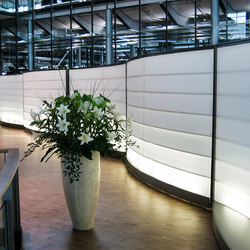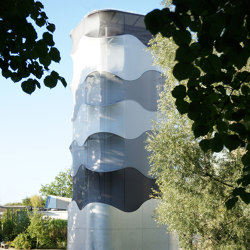Design Facades
Textile facades from Koch Membranen
Product description
Textile facade constructions offer the considerable benefits of low weight, exceptional durability and, in some cases, outstanding self-cleaning properties (dirt-repellent). The appeal of textile architecture is rooted in the organic forming of the constructions and the varying degrees of translucence – transparent or illuminated. Depending on their application these properties allow for the creation of the most diverse types of constructions. For example, it is possible to create surfaces with dual curvature either by mechanical preloading or pneumatic stabilisation. These systems are projected either as standard systems or tailored to fit individual architectural requirements.
Our approach allows us to craft designs that are intricate, yet durable enough to withstand any stress during temporary or permanent use. It is possible to freely arrange individual panels measuring up to 12x30 metres.
In addition to premium-quality silicon or PTFE-coated glass fabrics and coated polyester fabrics, we primarily use ETFE foils for the textile constructions embedded in the facade. The combination of their technical and physical properties defines the transparency of the construction. Thanks to its exceptional degree of transparency the material is used anywhere where a great influx of light and, thus, good clarity are foremost requirements. Sun and heat radiation is regulated by prints on the material, LowE coatings and the addition of colour pigments.
Our approach allows us to craft designs that are intricate, yet durable enough to withstand any stress during temporary or permanent use. It is possible to freely arrange individual panels measuring up to 12x30 metres.
In addition to premium-quality silicon or PTFE-coated glass fabrics and coated polyester fabrics, we primarily use ETFE foils for the textile constructions embedded in the facade. The combination of their technical and physical properties defines the transparency of the construction. Thanks to its exceptional degree of transparency the material is used anywhere where a great influx of light and, thus, good clarity are foremost requirements. Sun and heat radiation is regulated by prints on the material, LowE coatings and the addition of colour pigments.
Concept
There are few areas where attractive design and efficient construction are as closely intertwined as in textile / membrane construction. Whether used for buildings that pose a challenge from an engineering standpoint or for flexible, temporary structures – lightweight constructions allow for an unlimited range of shapes and impressive structures boasting enormous span widths. The primary purpose of textile constructions is and always has been to provide the best possible protection against the weather. The best products in this category provide this protection in the most economical and ecological way - at minimum use of material and maximised reduction of weight.
Possible applications
No matter if they are used for rigid or for single or multi-layer textile structures in building shells, membrane materials set themselves apart by their unique design and technical characteristics. Prime examples of the material's versatility are mobile, collapsible membranes used to span stadiums or atriums or membranes used in classic tent or pavilion structures. As they can be shaped into any type of construction including sails, arched roofs, tents, umbrellas or pneumatic structures, membranes allow for a whole plethora of possible textile structures and designs.
Selection of materials
The created architecture owes its distinctive look and feel to the selected materials and their surfaces – whether the material is wide-arching fabric or pneumatic foil cushions. The material is always selected to fit each specific application perfectly. The decision on the appropriate material hinges on the design principles, the ambient and environmental conditions and such factors as light permeability, durability or cost. Other aspects influencing the decision include the handling, workmanship or force-stretch behaviour of the material. Finding and tailoring the material that is best for each specific construction project calls for a detailed and profound knowledge of the different materials. In contrast to glass construction, textile architecture has come to the fore for many planners thanks to its impressive environmental footprint and outstanding economy.
Materials suited for textile architecture
PVC-coated polyester fabric
PTFE fabric
PTFE-coated glass fabric
Silicone-coated glass fabric
ETFE foil
Custom-engineered special fabrics
Possible applications
No matter if they are used for rigid or for single or multi-layer textile structures in building shells, membrane materials set themselves apart by their unique design and technical characteristics. Prime examples of the material's versatility are mobile, collapsible membranes used to span stadiums or atriums or membranes used in classic tent or pavilion structures. As they can be shaped into any type of construction including sails, arched roofs, tents, umbrellas or pneumatic structures, membranes allow for a whole plethora of possible textile structures and designs.
Selection of materials
The created architecture owes its distinctive look and feel to the selected materials and their surfaces – whether the material is wide-arching fabric or pneumatic foil cushions. The material is always selected to fit each specific application perfectly. The decision on the appropriate material hinges on the design principles, the ambient and environmental conditions and such factors as light permeability, durability or cost. Other aspects influencing the decision include the handling, workmanship or force-stretch behaviour of the material. Finding and tailoring the material that is best for each specific construction project calls for a detailed and profound knowledge of the different materials. In contrast to glass construction, textile architecture has come to the fore for many planners thanks to its impressive environmental footprint and outstanding economy.
Materials suited for textile architecture
PVC-coated polyester fabric
PTFE fabric
PTFE-coated glass fabric
Silicone-coated glass fabric
ETFE foil
Custom-engineered special fabrics
More about this product
Part of the collection
Our Solutions For Outside.
Manufacturer
Koch Membranen
Family
Textile Facade
Architonic ID
1435723
More products from Textile Facade family
Related Projects
Contact information
Address
Nordstrasse 1, 83253 Rimsting/Chiemsee Germany
Get more information
Sign in to your Architonic account to have your contact details filled out automatically for each request.

More from
Koch MembranenContact information
Address
Nordstrasse 1, 83253 Rimsting/Chiemsee Germany


